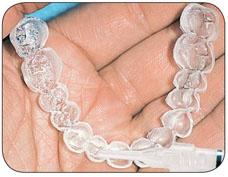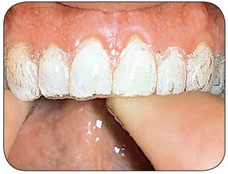Tooth whitening
Not only for skin and eye color, talent, but fundamentally the whiteness of teeth as well. The bright white teeth can prone to cavity, and a little more yellow colored teeth may be completely healthy. There is no correlation. The main purpose is to preserve the health of our teeth, to prevent the discoloration, which occur due to decay, but there is more we can do for white teeth.
There is a wide rande of reason of discolorations. The inherited properties, -some people's permanent teeth are darker-, and the child's circumstances may affect the development of tooth shade. During pregnancy the mother's consumed drugs can effect discoloration at the time of child's tooth development, especially by tetracycline antibiotic. Relatively well-known that the child's regular consumption of fluoride tablets overdose leave permanent yellowing strips on teeth.
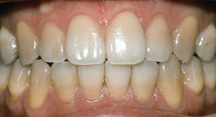 |
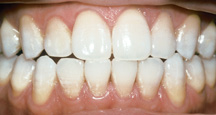 |
The healthy teeth can strongly yellowing and browning cigarette smoke, coffee and tea, but all food with intense color, red wine or red pepper as well.
Discoloration, gray shade may cause the old fillings, root canal treatmented teeth will not remain as white as before.
If not everyone will be the sane white teeth, more color shade lighting can be achieved with the appropriate bleach method. Of course, the result will not only depend on the original color, but also on how the dental tissue will react to the treatment. Somebody's teeth can easily bleach, sometimes the difference is much smaller than the we want.
The bleaching methods in common that active ingredient to penetrate into the porous material of teeth, and then release the discoloring materials. It's just able to get into the tooth, like discoloring agents. It also follows that the teeth whitening has never offered a finished solution. The color should be maintained, the treatment must be repeated periodically. Appropriate dental bleaching, carried out by dentist for years are usually effective.
|
At home or in the dentist's surgery? Here and there. The easiest way to bleach to use "whitening" toothpastes. Well, they are not all alike and do not replace the expected results, but there is no doubt that some among them are very good, which is well remove the discoloration and deposits from the surface of the tooth and prevent plaque production so could be successfully help to preserve the white color. Where the toothpaste is no longer be able to help, the bleaching at home or in the dentist's surgery can mean the solution.
The dentist first establish the exact nature and cause of discoloration.The carious teeth must be filled beforethewhitening, but the dental prosthesis and cosmetic filling replacement should wait for the end of the procedure.So we can choose color for the bleached teeth.
In addition, tooth whitening is always preceded the removal on the enamel deposited staining, plaque, or if necessary, polishing. The most common method is made by ultrasonic scaler device.
The easiest way to bleach is theTréswhite system, containing pre-prepared splints filled with bleaching gel. The advantage is its price disadvantage is difficulties of the application of the whitening gel.
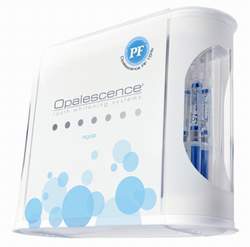
The individually prepared splint eliminates the former problem. For the at home bleaching the dentist takes an impression of the patient's teeth. Using the plaster model, the lab technician make a thin, transparent little plastic splint fitting to the patient's teeth. Little space is left in the splint for for the whitening substance. The gel-filled splint should be wornin the specified period. The procedure should be done under dental supervision, since their material is only available in dentistry.
In almost all cases teeth are noticeably whiter after the first treatment. In general, the third day has a significant whitening, which then slows down a bit. Eight to ten days in most cases is achieved the desired effect.
Using the individually prepared bleaching splint
After a carefully tooth brushing:
|
|
|
Pull a pottage size bleaching gel from syringe into the individually prepared splint |
Place the loaded splint. Remove the excess gel with fingers or toothbrush. |
After the required contact time, cleanthe splint with water and a toothbrush, and then insert it in the storage box. |
If teeth bleaching made in the dental surgery, the only difference is a much higher concentration of whitening gel. After very good isolation, the dentist takes the material on the surface of teeth and activated heat or blue light. This method has the advantage of not having to wear a splint, the disadvantage that expensive.
There is no hopeless case! If teeth have a very high degree of discoloration and the patient still want whiter teeth, can be made - especially the front and premolars - the preparation of a porcelain veneer, which is recommended for healthy teeth, but teeth should be prepared. In this case, it should be grinding the tooth surface, but the result is beautiful. In case of huge filling or damaged teeth, porcelain crown or bridge replacement is recommended.
Of course, not only all of teeth bleaching is possible. Some teeth can be treated separately, for example discolored tooth with root canal filling. Bleaching this grey teeth a different method require, which is made in the dental surgery, and need more treatment. First step is to remove the filling, cleaning thoroughly the tooth, and filling the crown with very concentrated solutionof bleaching material, using heat or light. The bleaching of these teeth can be combined with a the home bleaching method. The last treatment, the dentist make the corresponding colored composite filling.
Bridges and fillings are not to be bleachable , they should be to prepare according to the new color after bleaching.
![]()
1. Why do my teeth discolored?
Many things may affect the color of the teeth: certain foods and drinks, tobacco, drugs and diseases can cause unwanted discoloration. Usually the progress of the age also darkens the teeth.
2. Is it inevitably the tooth discoloration?
No. Nowadays there are many effective solution. One of the successful and proven way is the professional teeth whitening followed and controlled by your dentist.
3. How does it work?
The dentist after the dental examination (if necessary, professional dental cleaning and polishing), takes an impression of your teeth. Using this model the lab prepare a splint made of special foil. This is to be filled with home bleaching gel and applied to the teeth, 2-3 hours a day (Opalesence 20% whitening).
A special gel emit oxygen, which whitens the teeth discolorations humanely. The treatment takes 10-14 days.
4. Do I have to go to a dentist every time?
No. At the beginning of treatment the dentist make a treatment plan. A splint made and explain clearly to use it. So the treatment can be performed comfortably at home.
5. May anybody do the tooth whitening?
No. Contact your dentist. Some people, for example young children, pregnant women and nursing mothers can not make the bleaching. Your dentist will tell whether you can bleach your teeth.
6. How much does it takes to bleach the teeth?
It depens on the cause and extent of the discoloration. In many cases, the whitening of teeth is visible soon.
Usually food-borne discolorations disappear in 10-12 days. Discoloration caused by medicine or disease, the treatment may take several months.
7. Is the professional tooth whitening safe?
According to the today's position of the science neither the teeth, nor the mucosa does not harm the bleaching.
8. What are the side effects?
Taking a short period of time, tooth sensitivity and mucosal irritation may occur. The treatment is complete, these symptoms disappear.
9. Are to be avoided or at least reduced these symptoms?
Yeah, during the treatment citrus fruits and other acidic beverages should be avoided. The enclosed gel reduces the risk of irritation and sensitivity. The exact fit of the splint and correct applying of the gel and the correct treatment can contribute to your comfort. You will receive the appropriate advice of the treatment by dentist and which must be strictly followed.
10. Until how much time is the professional tooth whitening effective?
The succes highly depend on your lifestyle, the effect of treatment usually lasts 1-4 years. The dietary habits, smoking, age, and oral care major determinant of the effect's duration. For example, the frequent coffee, tea or red wine or smoking can lead to rapid discoloration.
11. How can I keep the whiteness of my teeth?
Good oral hygiene is the basis for pretty teeth for long time. Regular professional tooth cleaning contributes greatly to the success of treatment. If teeth discolored again, the treatment can be repeated. Usually the first treatment compared with the repeated treatment is much less intervention is required.
12. Does it whiten the fillings and crowns?
No. The professional teeth whitening effect only for natural teeth. Your dentist provides information about the advisability for you in the bleaching, as appropriate the crowns and fillings can be renewed.
13. Is there a filling, which is so white that it's color does not deviate from the bleached teeth?
Yes. There are fillings that are not different from bleached adjacent natural teeth. Ask your dentist.
14. The dentist's advice is essential in all cases?
Yes. Only your dentist can offer powerful tools. After your dental examination the dentist make h the treatment plan. A dentist's advice will help to avoid side effects and control the treatment's success.
In addition, you receive information to keep the professional whiteness and of course what you to do at home for your white teeth.



